劳动经济学作业参考答案
劳动经济学习题与答案
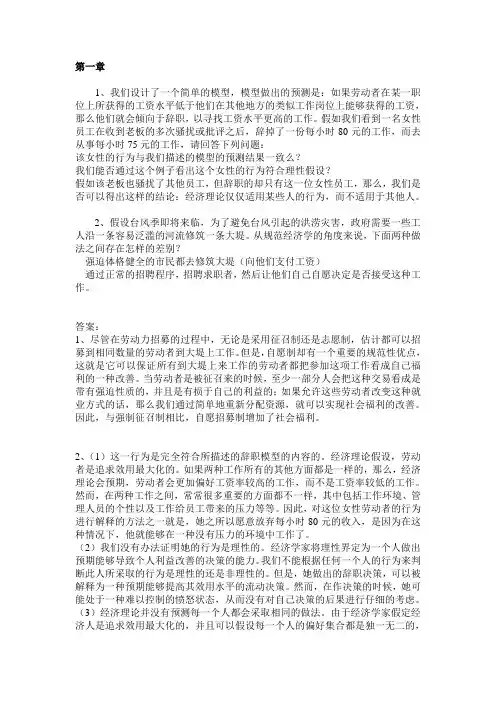
第一章1、我们设计了一个简单的模型,模型做出的预测是:如果劳动者在某一职位上所获得的工资水平低于他们在其他地方的类似工作岗位上能够获得的工资,那么他们就会倾向于辞职,以寻找工资水平更高的工作。
假如我们看到一名女性员工在收到老板的多次骚扰或批评之后,辞掉了一份每小时80元的工作,而去从事每小时75元的工作,请回答下列问题:该女性的行为与我们描述的模型的预测结果一致么?我们能否通过这个例子看出这个女性的行为符合理性假设?假如该老板也骚扰了其他员工,但辞职的却只有这一位女性员工,那么,我们是否可以得出这样的结论:经济理论仅仅适用某些人的行为,而不适用于其他人。
2、假设台风季即将来临,为了避免台风引起的洪涝灾害,政府需要一些工人沿一条容易泛滥的河流修筑一条大堤。
从规范经济学的角度来说,下面两种做法之间存在怎样的差别?强迫体格健全的市民都去修筑大堤(向他们支付工资)通过正常的招聘程序,招聘求职者,然后让他们自己自愿决定是否接受这种工作。
答案:1、尽管在劳动力招募的过程中,无论是采用征召制还是志愿制,估计都可以招募到相同数量的劳动者到大堤上工作。
但是,自愿制却有一个重要的规范性优点,这就是它可以保证所有到大堤上来工作的劳动者都把参加这项工作看成自己福利的一种改善。
当劳动者是被征召来的时候,至少一部分人会把这种交易看成是带有强迫性质的,并且是有损于自己的利益的;如果允许这些劳动者改变这种就业方式的话,那么我们通过简单地重新分配资源,就可以实现社会福利的改善。
因此,与强制征召制相比,自愿招募制增加了社会福利。
2、(1)这一行为是完全符合所描述的辞职模型的内容的。
经济理论假设,劳动者是追求效用最大化的。
如果两种工作所有的其他方面都是一样的,那么,经济理论会预期,劳动者会更加偏好工资率较高的工作,而不是工资率较低的工作。
然而,在两种工作之间,常常很多重要的方面都不一样,其中包括工作环境、管理人员的个性以及工作给员工带来的压力等等。
《劳动经济学》(作者Borjas)第五章习题答案
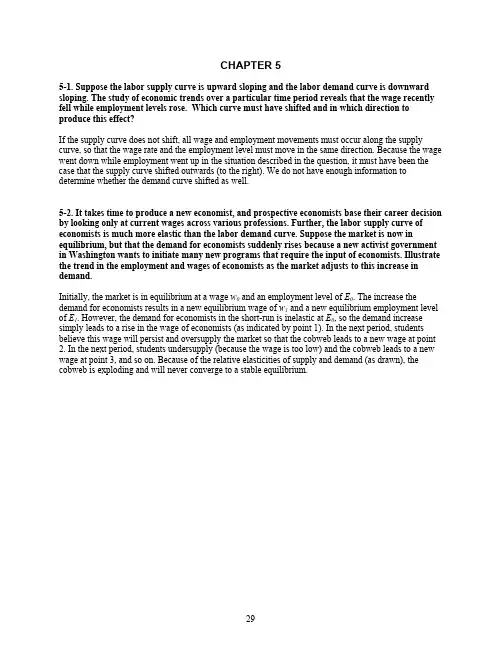
CHAPTER 55-1. Suppose the labor supply curve is upward sloping and the labor demand curve is downward sloping. The study of economic trends over a particular time period reveals that the wage recently fell while employment levels rose. Which curve must have shifted and in which direction to produce this effect?If the supply curve does not shift, all wage and employment movements must occur along the supply curve, so that the wage rate and the employment level must move in the same direction. Because the wage went down while employment went up in the situation described in the question, it must have been the case that the supply curve shifted outwards (to the right). We do not have enough information to determine whether the demand curve shifted as well.5-2. It takes time to produce a new economist, and prospective economists base their career decision by looking only at current wages across various professions. Further, the labor supply curve of economists is much more elastic than the labor demand curve. Suppose the market is now in equilibrium, but that the demand for economists suddenly rises because a new activist government in Washington wants to initiate many new programs that require the input of economists. Illustrate the trend in the employment and wages of economists as the market adjusts to this increase in demand.Initially, the market is in equilibrium at a wage w0 and an employment level of E0. The increase the demand for economists results in a new equilibrium wage of w1 and a new equilibrium employment level of E1. However, the demand for economists in the short-run is inelastic at E0, so the demand increase simply leads to a rise in the wage of economists (as indicated by point 1). In the next period, students believe this wage will persist and oversupply the market so that the cobweb leads to a new wage at point 2. In the next period, students undersupply (because the wage is too low) and the cobweb leads to a new wage at point 3, and so on. Because of the relative elasticities of supply and demand (as drawn), the cobweb is exploding and will never converge to a stable equilibrium.5-3. Suppose the supply curve of physicists is given by w = 10 + 5E , while the demand curve is given by w = 50 – 3E . Calculate the equilibrium wage and employment level. Suppose now that the demand for physicists increases and the new demand curve is given by w = 70 – 3E . Assume this market is subject to cobwebs. Calculate the wage and employment level in each round as the wage and employment levels adjust to the demand shock. (Recall that each round occurs on the demand curve – when the firm posts a wage and hires workers). What is the new equilibrium wage and employment level?The initial equilibrium is given by 10 + 5E = 50 – 3E . Solving these two equations simultaneously implies that w = $35 and E S = E D = 5. When demand increases to w = 70 – 3E , the new equilibrium wage is $47.5 and the equilibrium level of employment is 7.5.Round Wage Employment1 $55.0 52 $43.0 93 $50.2 6.64 $45.9 8.05 $48.4 7.26 $46.9 7.77 $47.8 7.48 $47.2 7.6The table gives the values for the wage and employment levels in each round. The values in the table are calculated by noting that in any given period the number of physicists is inelastically supplied, so that the wage is determined by the demand curve. Given this wage, the number of economists available in the next period is calculated. By round 7, the market wage rate is within 30 cents of the new equilibrium.01 w 1w 0W age5-4. The 1986 Immigration Reform and Control Act (IRCA) made it illegal for employers in the United States to knowingly hire illegal aliens. The legislation, however, has not reduced the flow of illegal aliens into the country. As a result, it has been proposed that the penalties against employers who break the law be increased substantially. Suppose that illegal aliens, who tend to be less skilled workers, are complements with native workers. What will happen to the wage of native workers if the penalties for hiring illegal aliens increase?A substantial increase in the penalties associated with hiring illegal aliens will likely reduce the number of illegal aliens entering the United States. The effect of this shift in the size of the illegal alien flow on the marginal product (and hence the demand curve) of native workers hinges on whether illegal aliens are substitutes or complements with natives. As it is assumed that natives and illegal aliens are complements, a cut in the number of illegal aliens reduces the value of the marginal product of natives, shifting down the demand for native labor, and decreasing native wages and employment.5-5. Suppose a firm is a perfectly discriminating monopsonist. The government imposes a minimum wage on this market. What happens to wages and employment?A perfectly discriminating monopsonist faces a marginal cost of labor curve that is identical to the supply curve. As a result, the employment level of a perfectly discriminating monopsonist equals theemployment level that would be observed in a competitive market (at E *) The imposition of a minimum wage at w MIN leads to the same result as in a competitive market: the firm will only want to hire E D workers as w MIN is now the marginal cost of labor, but E S workers will want to find work at the minimum wage. Thus, the wage increases, but employment falls.DollarsE w w *S D5-6. What happens to wages and employment if the government imposes a payroll tax on amonopsonist? Compare the response in the monopsonistic market to the response that would have been observed in a competitive labor market.Initially, the monopsonist hires E M workers at a wage of w M . The imposition of a payroll tax shifts the demand curve to VMP ′, and lowers employment to E ′ and the wage to w ′. Thus, the effect of imposing a payroll tax on a monopsonist is qualitatively the same as imposing a payroll tax in a competitive labor market: lower wages and employment. (It is interesting to note that the same result comes about if the payroll tax is placed on workers, so that the labor supply and marginal cost of labor curves shift as opposed to labor demand.)5-7. An economy consists of two regions, the North and the South. The short-run elasticity of labor demand in each region is –0.5. The within-region labor supply is perfectly inelastic. The labormarket is initially in an economy-wide equilibrium, with 600,000 people employed in the North and 400,000 in the South at the wage of $15 per hour. Suddenly, 20,000 people immigrate from abroad and initially settle in the South. They possess the same skills as the native residents and also supply their labor inelastically.(a) What will be the effect of this immigration on wages in each of the regions in the short run (before any migration between the North and the South occurs)?There will be no effect on the North’s labor supply in the short run, so the wage rate will not change there. In the South, labor supply will have increased by 5 percent, so the wage rate must fall by 5/(0.5) = 10 percent (recall that the elasticity of labor demand is -0.5, so a one percent decrease in wages would have been generated by a 0.5 percent expansion of the labor supply). The new hourly wage in the South, therefore, is $13.50 and total employment in the South is 420,000.DollarsEmploymentw M w ′(b) Suppose 1,000 native-born persons per year migrate from the South to the North in response to every dollar differential in the hourly wage between the two regions. What will be the ratio of wages in the two regions after the first year native labor responds to the entry of the immigrants?After the initial migration, we have seen that wages in the South are $13.50 while wages in the North are $15. This difference leads 1,500 natives migrating from the South to the North in the first year. Employment in the North after one year, therefore is 601,500. Moreover, as the elasticity of labor demand in the North is -0.5 and employment has increased by 0.25 percent, the Northern wage falls by 0.5 percent to roughly $14.93. Likewise, employment in the South after one year is 418,500. As the elasticity of labor demand is -0.5 and employment has decreased by 0.3571 percent, the Southern wage increases by0.71428 percent to roughly $13.60. Thus, the ratio of the Northern to Southern wage after one year is1.09779.(c) What will be the effect of this immigration on wages and employment in each of the regions in the long run (after native workers respond by moving across regions to take advantage of whatever wage differentials may exist)? Assume labor demand does not change in either region.In the long run, people must move from the South to the North to equalize the wage rates in the two regions. Since the wages were equal in the two regions before the influx of immigrants, and they also must be equal after things settle down, the proportional decrease in the wage rate should be the same in the North and in the South. Because the elasticity of labor demand is the same in the two regions, this last observation implies that the percentage increase in employment in the North must be the same as the percentage increase in employment in the South. Thus, as 60 percent of the original workers were employed in the North, 60 percent of the 20,000 increase in Southern employment will eventually migrate to the North. In the long run, therefore, total Northern employment will be 612,000 while total Southern employment will be 408,000. (Note: there is no presumption that only immigrants further migrate to the North.) In each region, therefore, employment increases by 2 percent in the long run, i.e., 12,000 is 2 percent of 600,000 and 8,000 is 2 percent of 400,000. (This can also be seen immediately as 20,000 is 2 percent of the 1 million workers.) Now, given that the elasticity of labor demand is -0.5, the 2 percent increase in employment will cause the wage rate to fall by 4 percent. Hence, the long-run equilibrium hourly wage will be $14.40.5-8. Chicken Hut faces perfectly elastic demand for chicken dinners at a price of $6 per dinner. The Hut also faces an upward sloped labor supply curve ofE = 20w – 120,where E is the number of workers hired each hour and w is the hourly wage rate. Thus, the Hut faces an upward sloped marginal cost of labor curve ofMC E = 6 + 0.1E.Each hour of labor produces 5 dinners. (The cost of each chicken is $0 as the Hut receives two-day old chickens from Hormel for free.) How many workers should Chicken Hut hire each hour to maximize profits? What wage will Chicken Hut pay? What are Chicken Hut’s hourly profits?First, solve for the labor demand curve: VMP E = P x MP E = $6 x 5 = $30. Thus, every worker is valued at $30 per hour by Chicken Hut. Now, setting VMP E = MC E yields 30 = 6 + .1E which implies E* = 240. Thus, Chicken Hut will hire 240 workers every hour. Further, according to the labor supply curve, 240 workers can be hired at an hourly wage of $18. Finally, Chicken Hut’s profits are Π = 240(5)($6) –240($18) = $2,880.5-9. Polly’s Pet Store has a local monopoly on the grooming of dogs. The daily inverse demand curve for pet grooming is:P = 20 – 0.1Qwhere P is the price of each grooming and Q is the number of groomings given each day. This implies that Polly’s marginal revenue is:MR = 20 – 0.2Q.Each worker Polly hires can groom 20 dogs each day. What is Polly’s labor demand curve as a function of w, the daily wage that Polly takes as given?As each worker can groom 20 dogs each day, and using Q = 20E, we have thatVMP E = MR x MP E = ( 20 – 0.2Q ) (20) = (20 – 4E)(20) = 400 – 80E.Thus, as Polly’s demand for labor satisfies VMP E = w, we have that her labor demand curve isE = 5 – 0.0125w.5-10. The Key West Parrot Shop has a monopoly on the sale of parrot souvenir caps in Key West. The inverse demand curve for caps is:P = 30 – 0.4 Qwhere P is the price of a cap and Q is the number of caps sold per hour. Thus, the marginal revenue for the Parrot Shop is:MR = 30 – 0.8Q.The Parrot Shop is the only employer in town, and faces an hourly supply of labor given by:w = 0.9E + 5where w is the hourly wage rate and E is the number of workers hired each hour. The marginal cost associated with hiring E workers, therefore, is:MC E = 1.8E + 5.Each worker produces two caps per hour. How many workers should the Parrot Shop hire each hour to maximize its profit? What wage will it pay? How much will it charge for each cap?First, as Q = 2E, the labor demand curve isVMP E = MR x MP E = (30 – 0.8Q)(2) = 60 – 1.6Q = 60 – 3.2E.Setting VMP E equal to MC E and solving for E yields E = 11. Eleven workers can be hired at a wage of.9(11) + 5 = $14.99 per hour. The 11 workers make 22 caps each hour, and the 22 caps can be sold at a price of 30 – 0.4(22) = $21.20 each.5-11. Ann owns a lawn mowing company. She has 400 lawns she needs to cut each week. Her weekly revenue from these 400 lawns is $20,000. If given an 18-inch deck push mower, a low-skill worker can cut each lawn in two hours. If given a 60-inch deck riding mower, a low-skill worker can cut the lawn in 30 minutes. Low-skilled labor is supplied inelastically at $5.00 per hour. Each laborer works 8 hours a day and 5 days each week.(a) If Ann decides to have her workers use push mowers, how many push mowers will Ann rent and how many workers will she hire?As each worker can cut a lawn in 2 hours, it follows that each worker can cut 4 lawns in a day or 20 lawns in a week. Therefore, Ann would need to rent 20 push mowers and hire 20 workers in order to cut all 400 lawns each week.(b) If she decides to have her workers use riding mowers, how many riding mowers will Ann rent and how many workers will she hire?As each worker can cut a lawn in 30 minutes, it follows that each worker can cut 16 lawns in a day or 80 lawns in a week. Therefore, Ann would need to rent 5 riding mowers and hire 5 workers in order to cut all 400 lawns each week.(c) Suppose the weekly rental cost (including gas and maintenance) for each push mower is $250 and the weekly rental cost (including gas and maintenance) of each riding mower is $1,800. What equipment will Ann rent? How many workers will she employ? How much profit will she earn?If Ann uses push mowers, her weekly cost of mowers is $250(20) = $5,000 while her weekly labor cost is $5(20)(40) = $4,000. Under this scenario, her weekly profit is $11,000. If Ann uses riding mowers, her weekly cost of mowers is $1,800(5) = $9,000 while her weekly labor cost is $5(5)(40) = $1,000. Thus, under this scenario, her weekly profit is $10,000. Therefore, under these conditions, Ann will rent 20 push mowers and employ 20 low-skill workers.(d) Suppose the government imposes a 20 percent payroll tax (paid by employers) on all labor and offers a 20 percent subsidy on the rental cost of capital. What equipment will Ann rent? How many workers will she employ? How much profit will she earn?Under these conditions, the cost of labor has increased to $6.00 per hour, while the rental costs for a push mower and a riding mower have decreased to $200 and $1,440 respectively. Ann’s profits under the two options, therefore, arePush-Profit = $20,000 – $200(20) – $6(20)(40) = $11,200.Rider-Profit = $20,000 – $1,440(5) – $6(5)(40) = $11,600.Thus, under these conditions, Ann rents riding mowers, hires 5 low-skill workers, and earns a weekly profit of $11,600.5-12. In the United States, some medical procedures can only be administered to a patient by a doctor while other procedures can be administered by a doctor, nurse, or lab technician. What might be the medical reasons for this? What might be the economic reasons for this?The American Medical Association might argue that doctors have more training and experience than nurses, and therefore, are the only professionals who can make certain decisions or perform certain procedures.Economically, the AMA has an incentive to restrict the number of people who can practice medicine (or perform certain procedures) in order to keep doctor wages high. If nurses were allowed to do everything they were capable of, fewer doctors would be demanded, and doctor wages would fall. From an economic viewpoint, therefore, the AMA restricts the supply of doctors, which keeps doctor wages artificially high.WageW restW unrestRestricted Supply ofDoctorsUnrestricted Supplyof DoctorsL rest L unrest Services Provided by DoctorsLabor Market For Medical Services Provided by Doctors。
劳动经济学课后习题参考答案
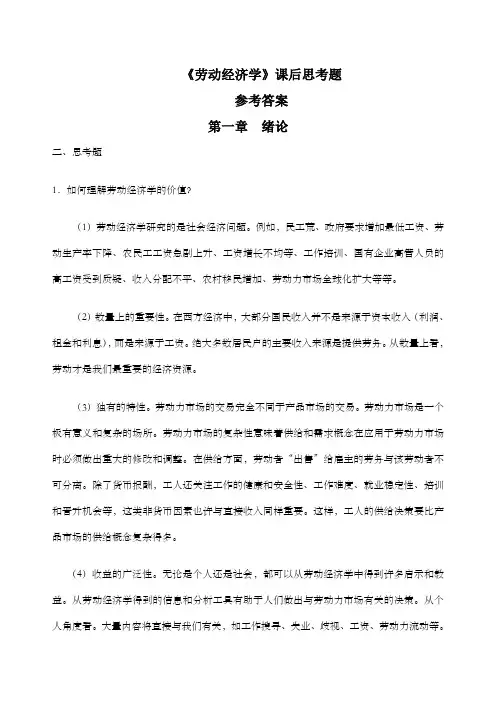
《劳动经济学》课后思考题参考答案第一章绪论二、思考题1.如何理解劳动经济学的价值?(1)劳动经济学研究的是社会经济问题。
例如,民工荒、政府要求增加最低工资、劳动生产率下降、农民工工资急剧上升、工资增长不均等、工作培训、国有企业高管人员的高工资受到质疑、收入分配不平、农村移民增加、劳动力市场全球化扩大等等。
(2)数量上的重要性。
在西方经济中,大部分国民收入并不是来源于资本收入(利润、租金和利息),而是来源于工资。
绝大多数居民户的主要收入来源是提供劳务。
从数量上看,劳动才是我们最重要的经济资源。
(3)独有的特性。
劳动力市场的交易完全不同于产品市场的交易。
劳动力市场是一个极有意义和复杂的场所。
劳动力市场的复杂性意味着供给和需求概念在应用于劳动力市场时必须做出重大的修改和调整。
在供给方面,劳动者“出售”给雇主的劳务与该劳动者不可分离。
除了货币报酬,工人还关注工作的健康和安全性、工作难度、就业稳定性、培训和晋升机会等,这类非货币因素也许与直接收入同样重要。
这样,工人的供给决策要比产品市场的供给概念复杂得多。
(4)收益的广泛性。
无论是个人还是社会,都可以从劳动经济学中得到许多启示和教益。
从劳动经济学得到的信息和分析工具有助于人们做出与劳动力市场有关的决策。
从个人角度看。
大量内容将直接与我们有关,如工作搜寻、失业、歧视、工资、劳动力流动等。
对于企业管理者来说,从对劳动经济学的理解中所得到的知识背景和分析方法,对做出有关雇用、解雇、培训和工人报酬等方面的管理决策也应该是十分有用的。
从社会角度看,了解劳动经济学将使人们成为更有知识、更理智的公民。
2.劳动经济学的研究方法有哪些?首先要明确劳动经济学的基本假设。
劳动经济学的假设主要表现在以下四个方面:(1)资源的相对稀缺性。
如同商品和资本是稀缺的一样,劳动力资源也是有限的。
时间、个人收入和社会资源的稀缺性构成了经济学分析的基本前提。
(2)效用最大化。
由于劳动资源的稀缺性,人类社会进行生产经营活动时,必须研究劳动资源的合理配置和利用。
劳动经济学课后习题答案整理
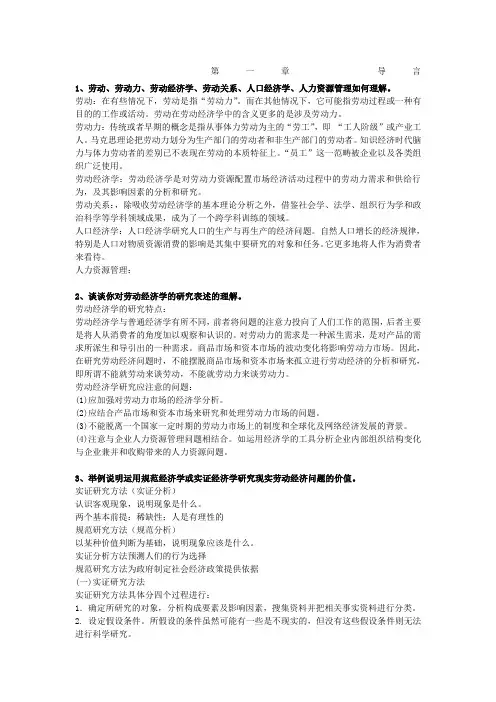
第一章导言1、劳动、劳动力、劳动经济学、劳动关系、人口经济学、人力资源管理如何理解。
劳动:在有些情况下,劳动是指“劳动力”。
而在其他情况下,它可能指劳动过程或一种有目的的工作或活动。
劳动在劳动经济学中的含义更多的是涉及劳动力。
劳动力:传统或者早期的概念是指从事体力劳动为主的“劳工”,即“工人阶级”或产业工人。
马克思理论把劳动力划分为生产部门的劳动者和非生产部门的劳动者。
知识经济时代脑力与体力劳动者的差别已不表现在劳动的本质特征上。
“员工”这一范畴被企业以及各类组织广泛使用。
劳动经济学:劳动经济学是对劳动力资源配置市场经济活动过程中的劳动力需求和供给行为,及其影响因素的分析和研究。
劳动关系:,除吸收劳动经济学的基本理论分析之外,借鉴社会学、法学、组织行为学和政治科学等学科领域成果,成为了一个跨学科训练的领域。
人口经济学:人口经济学研究人口的生产与再生产的经济问题。
自然人口增长的经济规律,特别是人口对物质资源消费的影响是其集中要研究的对象和任务。
它更多地将人作为消费者来看待。
人力资源管理:2、谈谈你对劳动经济学的研究表述的理解。
劳动经济学的研究特点:劳动经济学与普通经济学有所不同,前者将问题的注意力投向了人们工作的范围,后者主要是将人从消费者的角度加以观察和认识的。
对劳动力的需求是一种派生需求,是对产品的需求所派生和导引出的一种需求。
商品市场和资本市场的波动变化将影响劳动力市场。
因此,在研究劳动经济问题时,不能摆脱商品市场和资本市场来孤立进行劳动经济的分析和研究,即所谓不能就劳动来谈劳动,不能就劳动力来谈劳动力。
劳动经济学研究应注意的问题:(1)应加强对劳动力市场的经济学分析。
(2)应结合产品市场和资本市场来研究和处理劳动力市场的问题。
(3)不能脱离一个国家一定时期的劳动力市场上的制度和全球化及网络经济发展的背景。
(4)注意与企业人力资源管理问题相结合。
如运用经济学的工具分析企业内部组织结构变化与企业兼并和收购带来的人力资源问题。
劳动经济学课后习题参考答案完整版
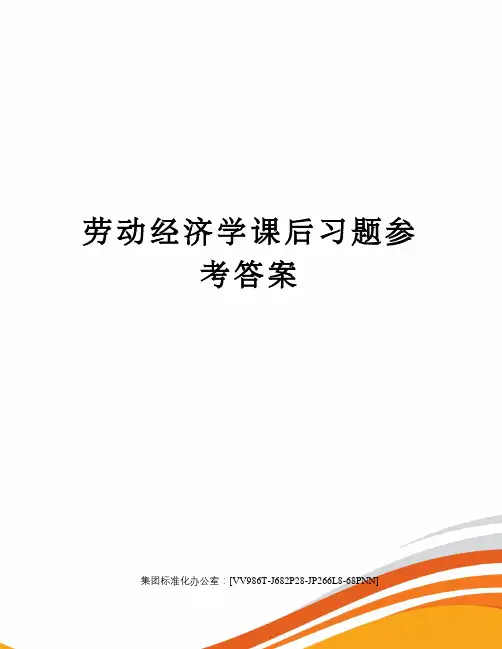
劳动经济学课后习题参考答案集团标准化办公室:[VV986T-J682P28-JP266L8-68PNN]《劳动经济学》课后思考题参考答案第一章绪论二、思考题1.如何理解劳动经济学的价值(1)劳动经济学研究的是社会经济问题。
例如,民工荒、政府要求增加最低工资、劳动生产率下降、农民工工资急剧上升、工资增长不均等、工作培训、国有企业高管人员的高工资受到质疑、收入分配不平、农村移民增加、劳动力市场全球化扩大等等。
(2)数量上的重要性。
在西方经济中,大部分国民收入并不是来源于资本收入(利润、租金和利息),而是来源于工资。
绝大多数居民户的主要收入来源是提供劳务。
从数量上看,劳动才是我们最重要的经济资源。
(3)独有的特性。
劳动力市场的交易完全不同于产品市场的交易。
劳动力市场是一个极有意义和复杂的场所。
劳动力市场的复杂性意味着供给和需求概念在应用于劳动力市场时必须做出重大的修改和调整。
在供给方面,劳动者“出售”给雇主的劳务与该劳动者不可分离。
除了货币报酬,工人还关注工作的健康和安全性、工作难度、就业稳定性、培训和晋升机会等,这类非货币因素也许与直接收入同样重要。
这样,工人的供给决策要比产品市场的供给概念复杂得多。
(4)收益的广泛性。
无论是个人还是社会,都可以从劳动经济学中得到许多启示和教益。
从劳动经济学得到的信息和分析工具有助于人们做出与劳动力市场有关的决策。
从个人角度看。
大量内容将直接与我们有关,如工作搜寻、失业、歧视、工资、劳动力流动等。
对于企业管理者来说,从对劳动经济学的理解中所得到的知识背景和分析方法,对做出有关雇用、解雇、培训和工人报酬等方面的管理决策也应该是十分有用的。
从社会角度看,了解劳动经济学将使人们成为更有知识、更理智的公民。
2.劳动经济学的研究方法有哪些首先要明确劳动经济学的基本假设。
劳动经济学的假设主要表现在以下四个方面:(1)资源的相对稀缺性。
如同商品和资本是稀缺的一样,劳动力资源也是有限的。
川农《劳动经济学(本科)》21年6月作业考核参考答案
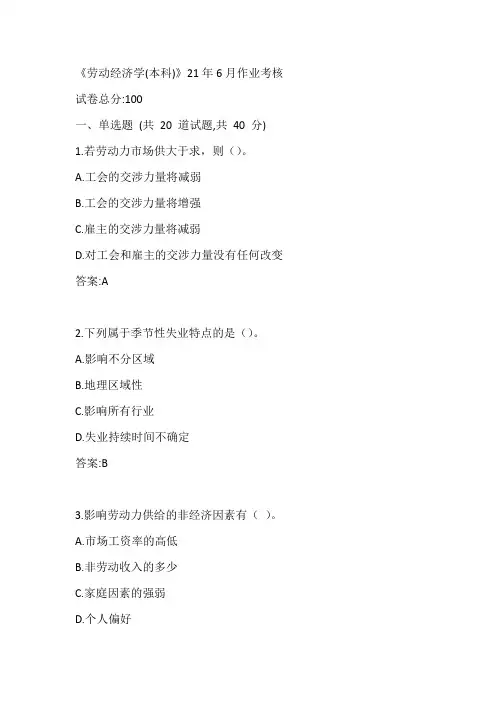
《劳动经济学(本科)》21年6月作业考核试卷总分:100一、单选题(共20 道试题,共40 分)1.若劳动力市场供大于求,则()。
A.工会的交涉力量将减弱B.工会的交涉力量将增强C.雇主的交涉力量将减弱D.对工会和雇主的交涉力量没有任何改变答案:A2.下列属于季节性失业特点的是()。
A.影响不分区域B.地理区域性C.影响所有行业D.失业持续时间不确定答案:B3.影响劳动力供给的非经济因素有()。
A.市场工资率的高低B.非劳动收入的多少C.家庭因素的强弱D.个人偏好答案:D4.如果某种劳动力需求的工资弹性大于l,说明该劳动力需求弹性是()。
A.无弹性B.无限弹性C.富有弹性D.缺乏弹性答案:C5.对于雇员而言,计时工资使其承担的风险较小,基本工资主要取决于()A.个人的努力程度B.完成产品数量的多少C.工作的紧张程度D.劳动时间的长度答案:D6.下列等式不正确的是()。
A.工资= 工资率×工作时间B.劳动报酬= 工资+ 福利C.收入= 劳动报酬+ 非劳动报酬D.收入- 工资= 非劳动报酬答案:D7.劳动力需求与工资率的关系是()。
A.正向关系B.反向关系C.双向关系D.没有关系答案:B8.作为工资的转化形式和劳动力价格重要构成部分的劳动报酬是()。
A.奖金B.津贴C.福利D.补贴答案:C9.其他条件不变,劳动力供给增加时,均衡工资率会()。
A.上升B.不确定C.不变D.下降答案:D10.从社会角度看,没有人遭受损失的交换称为()A.互惠B.互利C.互益D.互助答案:A11.公共部门的决策目标是()。
A.工作效果最大化B.成本最小化C.服务最大化D.利润最大化答案:C12.下列选项属于转移支付的是()。
A.国防用品B.社会优抚C.公共管理服务D.公共工程项目答案:B13.在市场经济中,劳动力供给的决策主体是()。
A.劳动者家庭或个人B.政府或公共部门C.行业工会D.企业或雇主答案:A14.影响实际工资的两个因素是()。
劳动经济学期末考试试卷(含答案)
劳动经济学期末考试试卷(含答案)一、单选题1. 劳动经济学的主要研究对象是:- A. 劳动力市场- B. 市场供需关系- C. 劳动组织与管理- D. 劳动工资支付问题- 答案:A2. 劳动力市场的特点之一是:- A. 劳动力雇佣自由度高- B. 劳动力需求较为稳定- C. 劳动力供给相对不足- D. 劳动力价格固定- 答案:A3. 以下哪种情况会导致劳动力需求减少?- A. 市场增长- B. 技术进步- C. 薪资提高- D. 政府干预- 答案:B二、判断题1. 劳动力市场的供给曲线是向上倾斜的。
- 正确2. 完全就业状态下,劳动力市场的失业率为0。
- 正确3. 劳动力市场的需求曲线是向上倾斜的。
- 正确三、简答题1. 解释劳动力市场中的劳动力流动性。
- 劳动力流动性指的是劳动者在劳动力市场中自由流动的能力和愿望。
劳动力流动性高意味着劳动者可以更容易地找到适合自己的工作机会,劳动力市场更加灵活。
劳动力流动性的好处包括促进经济发展、提高就业机会、增加劳动者的选择权等。
2. 名词解释:劳动力市场的弹性。
- 劳动力市场的弹性指的是劳动力供给和劳动力需求对于市场变动的敏感程度。
如果劳动力市场的供给和需求对市场变动反应较强烈,劳动力市场就被认为具有较高的弹性。
弹性高的劳动力市场更易适应变化,提高资源配置的效率。
四、计算题1. 某公司以每小时20元工资雇佣10名员工,每名员工每小时可生产10个单位商品。
如果该公司决定提高工资至每小时30元,则员工的工作效率提高至每小时可生产15个单位商品。
请计算该公司的劳动力成本效益是否提高。
- 原先每个单位商品的劳动力成本为20元/10个 = 2元/个- 现在每个单位商品的劳动力成本为30元/15个 = 2元/个- 劳动力成本效益未发生改变。
五、论述题就当前全球化背景下的劳动力市场问题进行论述,至少包括以下两个方面:1. 全球化对劳动力市场的影响;2. 如何应对全球化带来的劳动力市场问题。
《劳动经济学》(作者Borjas)第四章习题答案
CHAPTER 44-1. Suppose there are two inputs in the production function, labor and capital, and these two inputs are perfect substitutes. The existing technology permits 1 machine to do the work of 3 persons. The firm wants to produce 100 units of output. Suppose the price of capital is $750 per machine per week. What combination of inputs will the firm use if the weekly salary of each worker is $300? What combination of inputs will the firm use if the weekly salary of each worker is $225? What is the elasticity of labor demand as the wage falls from $300 to $225?Because labor and capital are perfect substitutes, the isoquants (in bold) are linear and the firm will use only labor or only capital, depending on which is cheaper in producing 100 units of output.The (absolute value of the) slope of the isoquant (MP E / MP K ) is 1/3 because 1 machine does the work of 3 men. When the wage is $900 (left panel), the slope of the isocost is 300/750. The isocost curve,therefore, is steeper than the isoquant, and the firm only hires capital (at point A ). When the weekly wage is $225 (right panel), the isoquant is steeper than the isocost and the firm hires only labor (at point B ).Weekly Salary = $300 Weekly Salary = $225The elasticity of labor demand is defined as the percentage change in labor divided by the percentage change in the wage. Because the demand for labor goes from 0 to a positive quantity when the wagedropped to $225, the (absolute value of the) elasticity of labor demand is infinity.LaborCapitalLaborCapital4-2. (a) What happens to the long-run demand curve for labor if the demand for the firm’s output increases?The labor demand curve is given by VMP E = MR x MP E. As demand for the firm’s output increases, its marginal revenue also increases. Thus, an increase in demand for the firm’s output shifts the labor demand curve to the right.(b) What happens to the long-run demand curve for labor if the price of capital increases?To determine how an increase in the price of capital changes the demand for labor, suppose initially that the firm is producing 200 units of output at point P in the figure. The increase in the price of capital (assuming capital is a normal input) increases the marginal costs of the firm and will reduce the profit-maximizing level of output to say 100 units. The increase in the price of capital also flattens the isocost curve, moving the firm to point R. The move from point P to point R can be decomposed into a substitution effect (P to Q) which reduces the demand for capital, but increases the demand for labor, and a scale effect (Q to R) which reduces the demand for both labor and capital. The direction of the shift in the demand curve for labor, therefore, will depend on which effect is stronger: the scale effect or the substitution effect.4-3. Union A wants to represent workers in a firm that hires 20,000 person workers when the wage rate is $4 and hires 10,000 workers when the wage rate is $5. Union B wants to represent workers in a firm that hires 30,000 workers when the wage is $6 and hires 33,000 workers when the wage is $5. Which union would be more successful in an organizing drive?The union will be more likely to attract the workers’ support when the elasticity of labor demand (in absolute value) is small. The elasticity of labor demand facing union A is given by:η = percent ∆L / percent ∆w = (20,000–10,000)/20,000 ÷ (4–5)/4 = –2.The elasticity of labor demand facing union B equals (33,000–30,000)/33,000 ÷ (5–6)/5 = –5/11 ≈ –.45. Union B, therefore, is likely to have a more successful organizing drive as 0.45 < 2.4-4. Consider a firm for which production depends on two normal inputs, labor and capital, with prices w and r, respectively. Initially the firm faces market prices of w = 6 and r = 4. These prices then shift to w = 4 and r = 2.(a) In which direction will the substitution effect change the firm’s employment and capital stock?Prior to the price shift, the absolute value of the slope of the isocost line (w/r) was 1.5. After the price shift, the slope is 2. In other words, labor has become relatively more expensive than capital. As a result, there will be a substitution away from labor and towards capital (the substitution effect).(b) In which direction will the scale effect change the firm’s employment and capital stock?Because both prices fall, the marginal cost of production falls, and the firm will want to expand. The scale effect, therefore, increases the demand for both labor and capital (as both are normal inputs).(c) Can we say conclusively whether the firm will use more or less labor? More or less capital?The firm will certainly use more capital as the substitution and scale effects reinforce each other in that direction, but the change in labor employed will depend on whether the substitution or the scale effect for labor dominates.4-5. What happens to employment in a competitive firm that experiences a technology shock such that at every level of employment its output is 200 units/hour greater than before?Because output increases by the same amount at every level of employment, the marginal product of labor, and hence the value of the marginal product of labor, does not change. Therefore, as the value of the marginal product of labor will equal the wage rate at the same level of employment as before, the level of employment will not change.4-6. Suppose the market for labor is competitive and the supply curve for labor is backwardbending over part of its range. The government now imposes a minimum wage in this labor market. What is the effect of the minimum wage on employment? Does the answer depend on which of the two curves (supply or demand) is steeper? Why?Equilibrium is attained where the supply curve intersects the demand curve, and the equilibriumemployment and wage levels are E* and w*, respectively . When the minimum wage is set at w MIN , the firm wants to hire E D workers but E S workers are looking for work. As long as the downward-sloping portion of the supply curve is to the right of the demand curve, the fact that the supply curve is downward sloping creates no problems beyond those encountered in the typical competitive model. An interesting extension of the problem would consider the case where the downward-sloping portion of the supply curve recrosses the demand curve at some point above w * and the minimum wage is set above that point.4-7. Suppose a firm purchases labor in a competitive labor market and sells its product in a competitive product market. The firm’s elasticity of demand for labor is −0.4. Suppose the wage increases by 5 percent. What will happen to the number of workers hired by the firm? What will happen to the marginal productivity of the last worker hired by the firm?Given the estimates of the elasticity of labor demand and the change in the wage, we have that4.0%%−=∆∆=w E η => 4.0%5%−=∆E=> %2%−=∆E .Thus, the firm hires 2 percent fewer workers. Furthermore, because the labor market is competitive, the marginal worker is paid the value of his marginal product. As the product market is also competitive, therefore, we know that the output price does not change so that the marginal productivity of the marginal worker increases by 5 percent.Employment W agesw M INS D4-8. A firm’s technology requires it to combine 5 person-hours of labor with 3 machine-hours to produce 1 unit of output. The firm has 15 machines in place and the wage rate rises from $10 per hour to $20 per hour. What is the firm’s short-run elasticity of labor demand?Unless the firm goes out of business, it will combine 25 persons with the 15 machines it has in place regardless of the wage rate. Therefore, employment will not change in response to the movement of the wage rate, and the short-run elasticity of labor demand is zero.4-9. In a particular industry, labor supply is E S = 10 + w while labor demand is E D = 40 − 4w, where E is the level of employment and w is the hourly wage.(a) What is the equilibrium wage and employment if the labor market is competitive? What is the unemployment rate?In equilibrium, the quantity of labor supplied equals the quantity of labor demanded, so that E S = E D. This implies that 10 + w = 40 – 4w. The wage rate that equates supply and demand is $6. When the wage is $6, 16 persons are employed. There is no unemployment because the number of persons looking for work equals the number of persons employers are willing to hire.(b) Suppose the government sets a minimum hourly wage of $8. How many workers would lose their jobs? How many additional workers would want a job at the minimum wage? What is the unemployment rate?If employers must pay a wage of $8, employers would only want to hire E D = 40 – 4(8) = 8 workers, while E S = 10 + 8 = 18 persons would like to work. Thus, 8 workers lose their job following the minimum wage and 2 additional people enter the labor force. Under the minimum wage, the unemployment rate would be 10/18, or 55.6 percent.4-10. Suppose the hourly wage is $10 and the price of each unit of capital is $25. The price of output is constant at $50 per unit. The production function isf(E,K) = E½K ½,so that the marginal product of labor isMP E = (½)(K/E) ½ .If the current capital stock is fixed at 1,600 units, how much labor should the firm employ in the short run? How much profit will the firm earn?The firm’s labor demand curve is it marginal revenue product of labor curve, VMP E, which equals the marginal productivity of labor, MP E, times the marginal revenue of the firm’s product. But as price is fixed at $50, MR = 50. Thus, we have thatVMP E = MP E× MR = (½)(1,600/E)½(50) = 1,000 / E½ .Now, by setting VMP E = w and solving for E, we find that the optimal number of workers for the firm to hire is 10,000 workers. The firm then makes (1600)½(10000)½ = 4,000 units of output and earns a profit of 4,000($50) – 1,600($25) – 10,000 ($10) = $60,000.4-11. Table 616 of the 2002 U.S. Statistical Abstract reports data on the nominal and real hourly minimum wage from 1960 through 2000. Under which president did the nominal minimum wage increase by the greatest dollar amount? Under what president did the real minimum wage increase by the greatest percentage?The data are:AdministrationsYear CurrentReal(2000)percentChangeNominalChange President1960 $1.00 $5.821961 $1.15 $6.621962 $1.15 $6.561963 $1.25 $7.03 20.79percent $0.25 Kennedy 1964 $1.25 $6.941965 $1.25 $6.831966 $1.25 $6.641967 $1.40 $7.221968 $1.60 $7.92 14.12percent $0.35 Johnson 1969 $1.60 $7.511970 $1.60 $7.101971 $1.60 $6.801972 $1.60 $6.591973 $1.60 $6.211974 $2.00 $6.99 -6.92percent $0.40 Nixon 1975 $2.10 $6.721976 $2.30 $6.96 3.57percent $0.20 Ford 1977 $2.30 $6.541978 $2.65 $7.001979 $2.90 $6.881980 $3.10 $6.48 -0.92percent $0.80 Carter 1981 $3.35 $6.351982 $3.35 $5.981983 $3.35 $5.791984 $3.35 $5.551985 $3.35 $5.361986 $3.35 $5.261987 $3.35 $5.081988 $3.35 $4.88 -23.15percent $0.00 Reagan 1989 $3.35 $4.651990 $3.80 $5.011991 $4.25 $5.371992 $4.25 $5.22 12.26percent $0.90 Bush 1993 $4.25 $5.061994 $4.25 $4.941995 $4.25 $4.801996 $4.75 $5.211997 $5.15 $5.531998 $5.15 $5.441999 $5.15 $5.322000 $5.15 $5.15 1.78percent $0.90 ClintonThe nominal minimum wage increased by the greatest dollar amount ($0.90) under both President Bush and President Clinton. In percentage terms, however, the real minimum wage increased by 12.26 percent during the Bush presidency, but only by 1.78 percent during the Clinton presidency. The greatest percent increase, however, came during the Kennedy presidency, when the minimum wage increased by over 20 percent.。
北语23春《劳动经济学》作业4-【辅导答案】
北语23春《劳动经济学》作业4试卷总分:100 得分:100一、单选题 (共 10 道试题,共 40 分)1.以下哪种措施是紧缩性货币政策()<A>项.增加政府转移支付<B>项.提高利率<C>项.减少政府购买<D>项.提高税率<正确答案>:B2.通常情况下,政府转移支付和补贴的增加与劳动力需求的增加之间有什么样的关系()<A>项.反向<B>项.正向<C>项.没有关系<D>项.不确定<正确答案>:B3.经济学中的静态均衡对调整时间是如何假设的()<A>项.认定经济变量调整中时间的重要性<B>项.调整时间很长<C>项.调整时间为零<D>项.调整时间较短<正确答案>:C4.芝加哥经济学派的代表人物弗里德曼对菲利普斯曲线加入了什么因素,从而提出了短期菲利普斯曲线和长期菲利普斯曲线()<A>项.过去<B>项.长期<C>项.预期<D>项.短期<正确答案>:C5.包括中国在内的很多国家与过去相比,人们的生命周期的显著变化是()<A>项.平均寿命大大延长<B>项.平均寿命大大缩短<C>项.平均寿命变化较小<D>项.平均寿命没有变化<正确答案>:A6.非全日制工作的每周工作时间与法定劳动时间的关系是什么()<A>项.两者相等<B>项.低于后者<C>项.高于后者<D>项.不确定。
《劳动经济学》练习题库参考答案
《劳动经济学》练习题库一. 名词解释1. 劳动经济学2. 工资刚性3. 自然失业率4. 就业弹性5. 工资指导线6. 统计性歧视7. 家庭生产函数8. 理性经济人9. 劳动力生产费用10. 内部劳动力市场11. 劳动边际生产力递减规律12. 劳动力参与率13. 余暇时间14. 非均衡分析15. 职业流动率16. 补偿性工资差别17. 就业结构18. 磨擦性失业19. 最低社会保障制度20. 帕金森定律二. 判断题1. 劳动力交换是人力资本与物力资本的结合。
2. 失业是价值规律调节劳动力供求的必然现象。
3. 内部劳动力市场的组织原理是源于价格或经济关系。
4. 人均收入最大化目标的企业存在着让劳动力流动的倾向。
5. 从劳动力供给的意愿性看,劳动力供给量即劳动力资源数量不等同于劳动力的实际使用量。
6. 道格拉斯——有泽法则认为丈夫的收入越高,妻子的劳动参与率越低。
7. 在劳动力市场上,雇主既有选择性又有流动性,而雇工只有选择性而没有流动性。
8. 福利按人而论,所以与劳动者的个人劳动量相关。
9. 计划经济假定人具有很高的觉悟,而市场经济假定人是合乎理性的经济人。
10. 我国所有的经济资源都是稀缺性的,惟有劳动力资源是相对过剩的。
11. 对劳动力市场的一般分析,是劳动经济学的逻辑起点。
12. 劳动力的生产费用即人力投资的直接费用与间接费用之和。
13. 劳动力市场的供给方式是其供给主体和供给客体分属于不同的劳动者。
14. 劳动力价格等于人力资源成本。
15. 劳动力市场即买卖劳动者的市场。
16. 劳动力供需均衡是经常的、永久性的。
17. 劳动投入收益理论,是揭示劳动投入与劳动成本之间的数量关系的理论。
18. 劳动力资源同一切经济资源一样具有稀缺性。
19. 规范分析方法不用一定的价值观去评价经济效益的好坏和制度政策的利弊。
20. 内部劳动力市场与外部劳动力市场的关系是一种内部制度性与外部价格性的关系。
21. 劳动力的需要是一种不需要以货币支付能力作为后盾的主观愿望。
- 1、下载文档前请自行甄别文档内容的完整性,平台不提供额外的编辑、内容补充、找答案等附加服务。
- 2、"仅部分预览"的文档,不可在线预览部分如存在完整性等问题,可反馈申请退款(可完整预览的文档不适用该条件!)。
- 3、如文档侵犯您的权益,请联系客服反馈,我们会尽快为您处理(人工客服工作时间:9:00-18:30)。
读书破万卷下笔如有神《劳动经济学》作业参考答案一、单项选择题1.劳动经济学的研究对象是( D )A.稀缺的信息资源配置问题 B.稀缺的技术资源配置问题D.稀缺的土地资源配置问题.稀缺的劳动资源配置问题 C2.如果两类劳动力是总替代关系,则一类劳动力的工资率上升会引起另一类劳动力( C )A.供给的增加 B.供给的下降D .需求的下降 C.需求的增加3.引起劳动力需求量变动的根本原因是( A )A.工资率 B.生产技术D.企业的性质 C.货币资本规模4.在其他条件不变的情况下,由于对教育、培训有较高回报的预期,因此,人力资本投资增加,将使( A )A.劳动供给增加 B.劳动供给减少D.劳动需求增加C .劳动需求减少5.在工资率和收入水平较低的情况下,随着工资率提高,劳动者将增加劳动供给。
造成这种现象的原因是( A )A.收入效应 B.替代效应D.收入效应大于替代效应 C.收入效应小于替代效应6.如果某种劳动力供给弹性系数等于零,则该劳动力供给弹性为( A )A.无弹性 B.单位弹性D .富有弹性 C.缺乏弹性7.劳动力市场达到充分就业的条件是( C )A.劳动力市场上供给大于需求 B.劳动力市场上供给小于需求C.市场工资率等于均衡工资率 D.市场工资率低于均衡工资率) B .下列各项培训成本中,属于培训投资机会成本的是(8.读书破万卷下笔如有神A.雇员在接受培训期间的工资 B.接受培训的人员在培训期间对产量的影响C.租用培训场地的费用 D.培训教材费用9.计件工资的适用范围是( C )A.机械化、自动化程度高的行业和企业B.产品数量和质量不易准确确定的行业和企业C.产品数量和质量能准确计算检验的行业和企业D.产品、经营项目较多和生产条件多变的行业和企业10.如果某劳动力市场存在地区或行业卖方垄断,则( D )A.其他地区或行业的就业量减少 B.该地区或行业工资率低于市场均衡工资率C.该地区或行业的就业量增加 D.该地区或行业的劳动力供给曲线左移11.下列关于货币工资和实际工资变动关系的正确表述是( A )A.若货币工资不变,当商品价格上升,则实际工资下降B.若货币工资不变,当商品价格上升,则实际工资上升C.若商品价格不变,当货币工资上升,则实际工资不变D.若商品价格不变,当货币工资上升,则实际工资下降12.从总供给角度来分析通货膨胀成因的通货膨胀类型是( B )A.需求拉上型通货膨胀 B.成本推进型通货膨胀D.惯性通货膨胀 C.结构调整型通货膨胀13.一般认为,充分就业的数量标准是失业率控制在( B )A.0—1%之间 B.3—5%之间C.8—10%之间 D.10—15%之间14.个人劳动力供给曲线与其他供给曲线存在明显区别,即“向后弯曲”。
造成这种结果的主要原因是( B )A.收入效应大于替代效应 B.收入效应小于替代效应D C.总互补关系.总替代关系15.劳动力供给与劳动力需求通过竞争达到均衡时,将导致( A )A.充分就业 B.劳动力供给过剩D .劳动力需求不足.劳动力供给不足C ) D 当员工接受了企业的特殊培训后,培训收益的确定原则是(16.读书破万卷下笔如有神A.全部归企业享有 B.全部归员工享有C.在企业与员工之间均等享有D.根据特殊培训的成本支付情况来确定归哪方享有17.适宜采用计时工资计算工资报酬的行业和企业是( D )A.产品数量、质量可以检验的生产行业和企业B.产品的数量与质量取决于工人的勤奋与努力的行业和企业C.品种单一且需要大批量进行生产的行业和企业D.产品数量标准不易精确确定,产品(服务)数量难以度量的行业和职业18.下列劳动类型中,属于就业范畴的是( B )A.家务劳动 B.雇用劳动D.救济性劳动.义务劳动 C19.下列哪位学者的失业理论属于货币学派的失业理论?( C )A.萨伊B.凯恩斯D.刘易斯弗里德曼C.20.下列哪个选项是政府收入的最主要部分?( B )A.政府采购B.税收D.职业许可C.配额21. 完全竞争的市场环境下,对单个企业来说,劳动力供给曲线是( C )A.水平的B.垂直的C.凹向原点的曲线D.斜率为负的直线22.收入分配越不平等,则基尼系数( C )A.越小B.不变C.越大D.无法确定23.一般来说,衡量失业水平的常用尺度是( A )A.失业率B.失业人数C.年失业率D.平均失业周数24.一般情况下,集体谈判的双方是( D )A.雇员与工会B.雇主与雇主团体雇主或雇主团体与工会D. 雇员与雇主C.读书破万卷下笔如有神25.劳动力市场的基本功能是( C )A.决定就业量B.决定物价D.决定工资和物价水平 C.决定就业量和工资26.劳动力供给富有弹性时,其劳动力供给曲线( B )A.较为陡峭B.较为平坦C.与横轴平行D.与横轴垂直27.边际劳动产量最终都要下降,这是因为( C )A.新增加的劳动力本身技术较差B.新增加的工人工资较高C.资本变得相对稀缺D.资本变得相对过剩28.生产劳动密集型产品的企业,其劳动力需求弹性( B )A.为零B.大D. 为单位弹性 C.小29.一般培训的成本通常由______来支付。
( A )A.企业B.员工D.社会 C.政府30.收入分配完全不均等时,基尼系数等于( B )A.0B.1D.2C.-131.下列会使企业减少对劳动力需求的政策是( D )A.扩张性的货币政策B.扩张性的财政政策D.鼓励就业的政策紧缩性的货币政策 C.32.下列不属于劳动者行为目标的是( B )A.工资B.利润最大化D.职业的稳定性C.劳动条件33.劳动供给曲线向左上方向移动,说明劳动力供给( B )A.增加B.减少难以判定不变C. D. 34. 等产量线的斜率为(B )负B. 正A.读书破万卷下笔如有神C.1D.不确定35.短期内,其他的生产要素是不变的,唯一可变的生产要素是___投入。
( C )A.土地B.资本D.技术 C.劳动36.劳动力需求增加而劳动力供给不变时,均衡工资率( A )A.上升B.下降D.不确定C.不变37.人力资本理论的思想发端于( A )A.亚当·斯密B.大卫·李嘉图D. C.西奥多·舒尔茨加里·贝克尔38. 假定其他条件不变,工资总额不变而劳动时间缩短,则劳动供给( B )。
A.增加B.减少C.不变D.不确定39.两种劳动力间为总替代关系时,其交叉工资弹性为( A )。
A.正B.负D. 任意值 C.零40.集体谈判的双方为( B )。
A.雇主和员工B.雇主和工会D. 政府和工会 C.雇主和政府41.劳动力需求增加,劳动力供给也增加,则均衡工资率( D )。
A.减少B.增加C.不变D.不确定42.劳动力供给曲线不变,劳动力需求曲线右移,对均衡工资率和均衡就业量的影响是( D )A.减少,减少B.减少,增加C.增加,减少D.增加,增加43. ( B )不属于正常失业。
A.结构性失业B.摩擦性失业季节性失业 D.周期性失业 C.读书破万卷下笔如有神44.一般说来,扩张性的财政政策是以( B )为主要目标。
A.抑制通货膨胀B.提高就业水平C.消除赤字D.消除贫富差距45. 一般情况下,实际工资水平总是_______货币工资水平。
( A )A.低于B.等于D. 无法确定 C.高于46.下列哪一项属于劳动力的生产间接费用?( B ) A.生产费用 B.教育费用D.社会公共支出 C.工时损失费用47.下列选项中属于实物支付形式的福利是( D )A.支付股权 B.支付失业保险金C.带薪休假 D.支付退休金48.早期的菲利普斯曲线的主要结论是( C )A.失业率与货币工资变动率同时上升B.失业率与货币工资变动率同时下降C.失业率与货币工资变动率之间是此消彼涨的关系D.失业率等于货币工资变动率49.下列属于大学教育人力资本投资费用中的间接成本的是( D )A.上大学花费的学杂费B.上大学花费的书本费C.上大学花费的生活费D.因上大学而放弃的可能的工资收入50.政府雇员和事业组织中劳动者的薪金报酬是属于( C )A.政府的社会福利B.政府的社会补贴C.政府购买D.政府的转移支付二、名词解释题01.失业率:P27602. 人力资本:P32303.工资谈判:P24804.周期性失业:P307P305结构性失业:05.读书破万卷下笔如有神三、简答题01. 简要回答影响就业的因素分析。
P28202.简要回答企业内部因素对工资水平的影响。
P235 03.简要回答按要素分配的方式。
P21304.简要回答人力资本的特点。
P323四、论述题01.试论述企业劳动关系调整的形式。
P39902.试论述工资差别的成因。
P 256五、计算题:根据表所给资料,求该地区失业率。
受教育程就业人(万人失业人(万人804小学及以6110小学至初8120初中至高2高中以90P 276*100%失业人数)+(就业人数/(失业人数)=失业率.。
